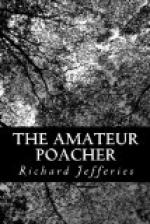When the smoke has cleared away in the crisp air, there he lies, the yet warm breast on the frozen ground, to be lifted up not without a passing pity and admiration. The brown feathers are exquisitely shaded, and so exactly resemble the hue of the rough dead aquatic grass out of which he sprang that if you cast the bird among it you will have some trouble to find it again. To discover a living snipe on the ground is indeed a test of good eyesight; for as he slips in and out among the brown withered flags and the grey grass it requires not only a quick eye but the inbred sportsman’s instinct of perception (if such a phrase is permissible) to mark him out.
If your shot has missed and merely splashed up the water or rattled against bare branches, then step swiftly behind a tree-trunk, and stay in ambuscade, keeping a sharp watch on him as he circles round high up in the air. Very often in a few minutes he will come back in a wide sweep, and drop scarcely a gun-shot distant in the same watercourse, when a second shot may be obtained. The little jack snipe, when flushed, will never fly far, if shot at several times in succession, still settling fifty or sixty yards farther on, and is easily bagged.
Coming silently as possible round a corner, treading gently on the grass still white with hoar-frost in the shadow of the bushes, you may chance to spring a stray woodcock, which bird, if you lose a moment, will put the hedge between him and you. Artists used to seek for certain feathers which he carries, one in each wing, thinking to make of them a more delicate brush than the finest camel’s hair.
In the evening I used to hide in the osier-beds on the edge of a great water-meadow; for now that the marshes are drained, and the black earth of the fens yields a harvest of yellow corn, the broad level meads which are irrigated to fertilise them are among the chief inland resorts of wild fowl. When the bright moon is rising, you walk in among the tapering osier-wands, the rustling sedges, and dead dry hemlock stems, and wait behind an aspen tree.
In the thick blackthorn bush a round dark ball indicates the blackbird, who has puffed out his feathers to shield him from the frost, and who will sit so close and quiet that you may see the moonlight glitter on his eye. Presently comes a whistling noise of wings, and a loud ’quack, quack!’ as a string of ducks, their long necks stretched out, pass over not twenty yards high, slowly slanting downwards to the water. This is the favourable moment for the gun, because their big bodies are well defined against the sky, and aim can be taken; but to shoot anything on the ground at night, even a rabbit, whose white tail as he hops away is fairly visible, is most difficult.




